12. Soft robotics¶
INDEX IMAGE ~ Dionaea muscipula, Venus fly trap. Movement is enabled by tiny hairs that line its two leaf lobes, which act like motion sensors and trigger the leaves to snap from convex to concave
Research and Lecture¶
This week we are studying soft robotics. To begin, how do we define soft?
- bendy, squishy, squeezable, silky, plushy
- easy to mold, cut, compress, or fold; not hard or firm to the touch
- having a pleasing quality involving a subtle effect or contrast rather than sharp definition
Nature has incredible examples of soft biodegradable/sustainable materials and soft technologies/interactions that allow energy and motion transfers. Soft robots need actuation - we can call these soft actuators and they can be fluidic, chemical, biological, thermal, magnetic or different hybrids of these. We are learning to cast silicon (and other biomaterial replacements) and heat pressing/sealing vinyl to create layered materials with inflatable chambers.

 Here are some example materials, techniques and variables used in making simple inflatables from an MIT study:
Here are some example materials, techniques and variables used in making simple inflatables from an MIT study:

Technology to support intimacy, sex and body care¶
Talk with Brujxs Lab¶
Brujxs Lab is a nomadic lab of biohacking and witchcraft rituals by Giulia Tomasello and Cristina Dezi. They create projects around intimate biotechnology, body fluids, sexuality and microbiology. They also promote citizen science - open participation in the culture and knowledge of science and explore practices of care in science-based research projects. Here you can see some of their work that uses body fluids such as period blood for color and texture in biomaterials and underwear that could potentailly monitor vaginal health with a sensor.
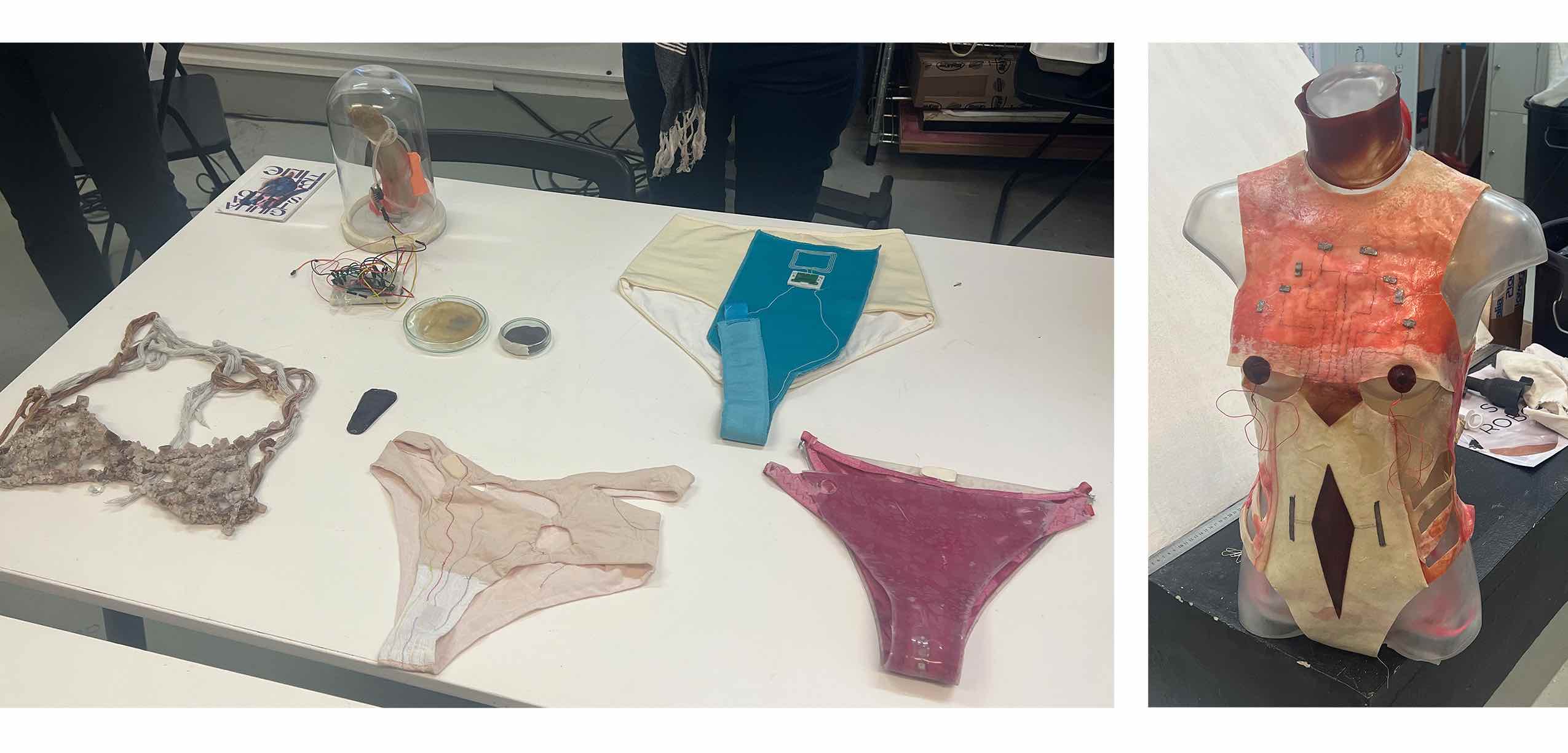
Talk with Joo Young Park¶
Interesting questions addressed in her research:
- How does it feel when robots touch our bodies? What is robot-human intimacy?
- How to fabricate delicate and nuanced touch? (noises, size, gentle or firmness)
- How to handle body data (ethics and surveillance)?
- What are sustainable and body safe materials?
References¶
Soft sea organisms can serve as inpiration for designing soft robotic structures:

Chromatose micro-pneumatic 3d printed responsive blossoms¶
Mark Wilson printed these concave petals made from Tango (rubber-like material) and Vero. Each one has small channels embedded, which makes them respind pneumatically into a convex shape. They snap back into a concave position with a light touch.
Inflated robotics examples by Materiability¶
Auto Inflatables by Chemical Reaction by MIT Tangible Media Group¶
3d Printed Inflatables by MIT¶
Knitting Techniques for Soft Robotics¶
Soft Robotics Materials¶
- Tpu
- Silicones and Metasilacones
- Latex rubbers
- Gelatin (silicone replacement)
- Baking paper
- Nylon finishing wire
- Vinyl
Soft Robotics Physical Tools¶
- Laser cutter, vinyl cutter
- 3d printer
- Heat press
- Syringes
- Peristaltic Pump, Air pump
- Valves, Solenoid valve
Process and Workflow¶
Breath Inflated Lung Accessory¶
For a silicone piece I was inspired by similar images of lungs and tree branches on this instagram account Geometry in Nature. I wanted to try to make a chest accesory that could inflate with breath and reveal a blood vessel-like pattern.

Step 1 - Rhino Modeling¶
I started modeling some abstract branch shapes and a center canal leading upwards where the pipes would connect. To make the piece symmetrical I used the Mirror command. I was thinking to have the piece inflate by two pipes that I could connect with a mouth piece that would have a plug so the accessory can stay inflated for a while. And once blown up, the pipes could go around the neck doubling as straps like a necklace.
 In the mold file you need to remember to make a base part, the inner airflow part, and an outline. You need to cut x2 of the outline to make the walls higher than the inner part of the mold.
In the mold file you need to remember to make a base part, the inner airflow part, and an outline. You need to cut x2 of the outline to make the walls higher than the inner part of the mold.
 I added little tabs that would be filled with silicone on the side because I remmebered I may need to add a strap that goes around the chest and connects in the back. The final model ready for lasercut: 1
I added little tabs that would be filled with silicone on the side because I remmebered I may need to add a strap that goes around the chest and connects in the back. The final model ready for lasercut: 1

Step 2 - Laser Cutting Acrylic and Assembling Mold¶
Material: Transparent acrylic 3mm


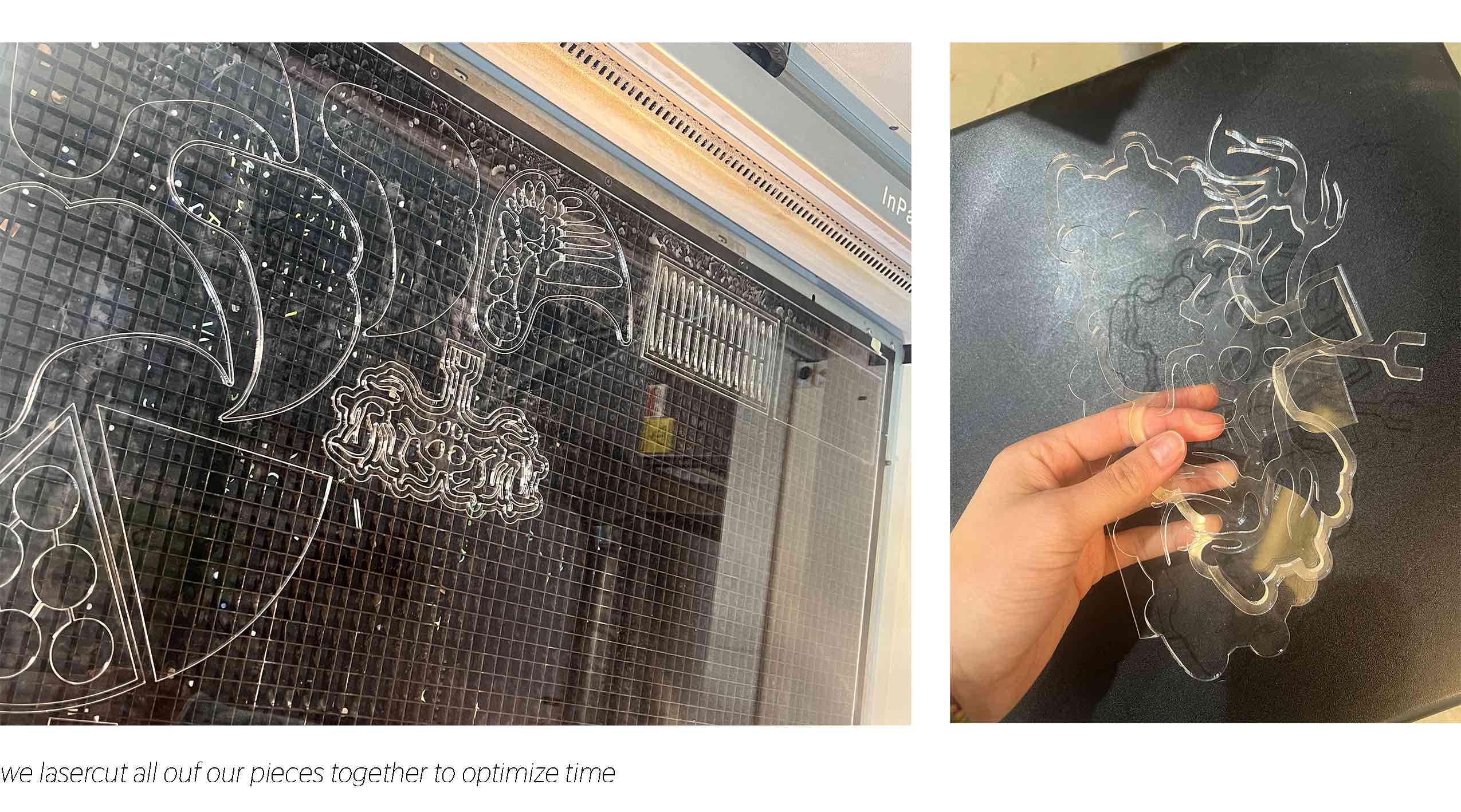 Assembly:
Assembly:

Step 3 - Silicone Casting¶
 Calculate the amount you need:
Calculate the amount you need:
- Turn the base layer into a surface and extrude by 3mm (thickness of acrylic)
- Take that volume
- Turn the inner air chamber part into a surface and extrude by 3mm
- Take that volume
- Subtract the inner amount from the base amount and you will have a number in cubic mm
- Convert this to mL
- Use a little bit more to ensure you have enough silicone
Casting Process:
- mix the two part solution together using 1:1 ratio
- work fast because it will immeditaly start to set
- start from one corner, hold the mold at an angle and slowly let the mix flow into the mold to avoid air bubbles
- leave the mold on a flat surface to cure
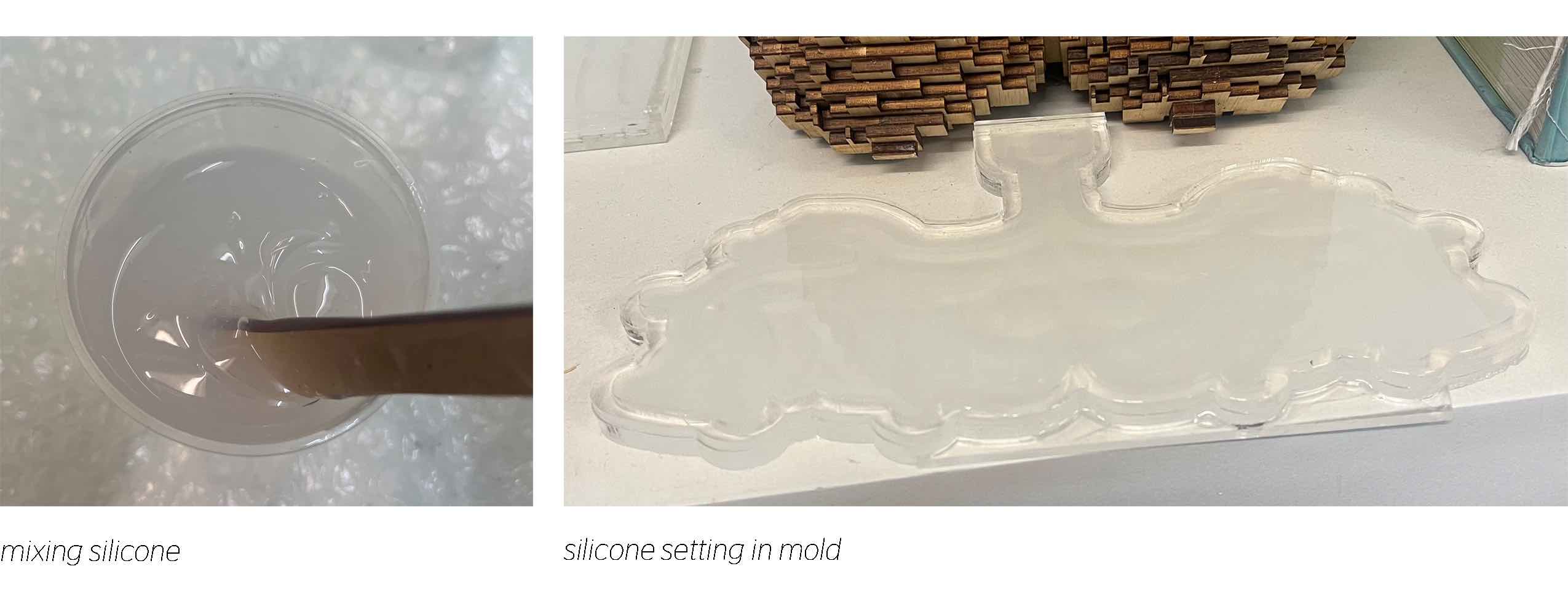 You can either cast in the mold twice to make a double sided inflatable or cast silicone on a flat surface or textile/material to keep the inflatable onesided. I cast left-over silicone on a flat surface and it left me with a piece that was very thin and just big enough to fit against the other half. I used silicone to "glue" it to the other half and put extra around the edges where the piece was dangerouly thin.
You can either cast in the mold twice to make a double sided inflatable or cast silicone on a flat surface or textile/material to keep the inflatable onesided. I cast left-over silicone on a flat surface and it left me with a piece that was very thin and just big enough to fit against the other half. I used silicone to "glue" it to the other half and put extra around the edges where the piece was dangerouly thin.
 Then I tried to cut off the edges of the second piece. I used a blade but it was difficult because the silicone is so flexible and stretchy. I think it is better to cast carefully in molds to avoid the need to cut the edges.
Then I tried to cut off the edges of the second piece. I used a blade but it was difficult because the silicone is so flexible and stretchy. I think it is better to cast carefully in molds to avoid the need to cut the edges.
Results¶
 I ended up needing to cut off the top part with two airflow passage ways because one silicone part ripped and it was preventing the piece from inflating well. So this video shows inflation ib just the one passage way using a syringe.
I ended up needing to cut off the top part with two airflow passage ways because one silicone part ripped and it was preventing the piece from inflating well. So this video shows inflation ib just the one passage way using a syringe.
Notes and corrections for a second prototype:¶
- make the whole piece bigger so each tendril/branch could have it's own offset and the whole shape wouldn't be covered in silicone
- make the air passage ways bigger for a more dramatic inflation effect
- make a thin acrylic mold with no air canals to make create a big and flat silicone piece for a sleek surface layer (since I casted mine flat with limited silicone it was in a different shape and kind of messy)
- play with geometries that would make the tendrils curve and move more when inflated
Twisting Vinyl Sample¶
For the vinyl inflatable I wanted to try this twisting sample from the MIT study. I first used exactly their design to understand the functionality, but it didn't quite work. The air was getting stuck and only inflating the first half and it was not twisting at all. I tried two other patterns, making them smaller and with the focus on the diagonal lines. My idea was to add petals on the side of the rectangle so they would spread out when it twists because I wanted to see what aesthetic changes these moving inflatables could create.

Step 1 - Illustrator/Rhino Modeling¶
 Here is the file with all three designs: 2
Here is the file with all three designs: 2
Step 2 - Laser Cutting¶
Material: Baking paper (taped on cardstock to hold better)

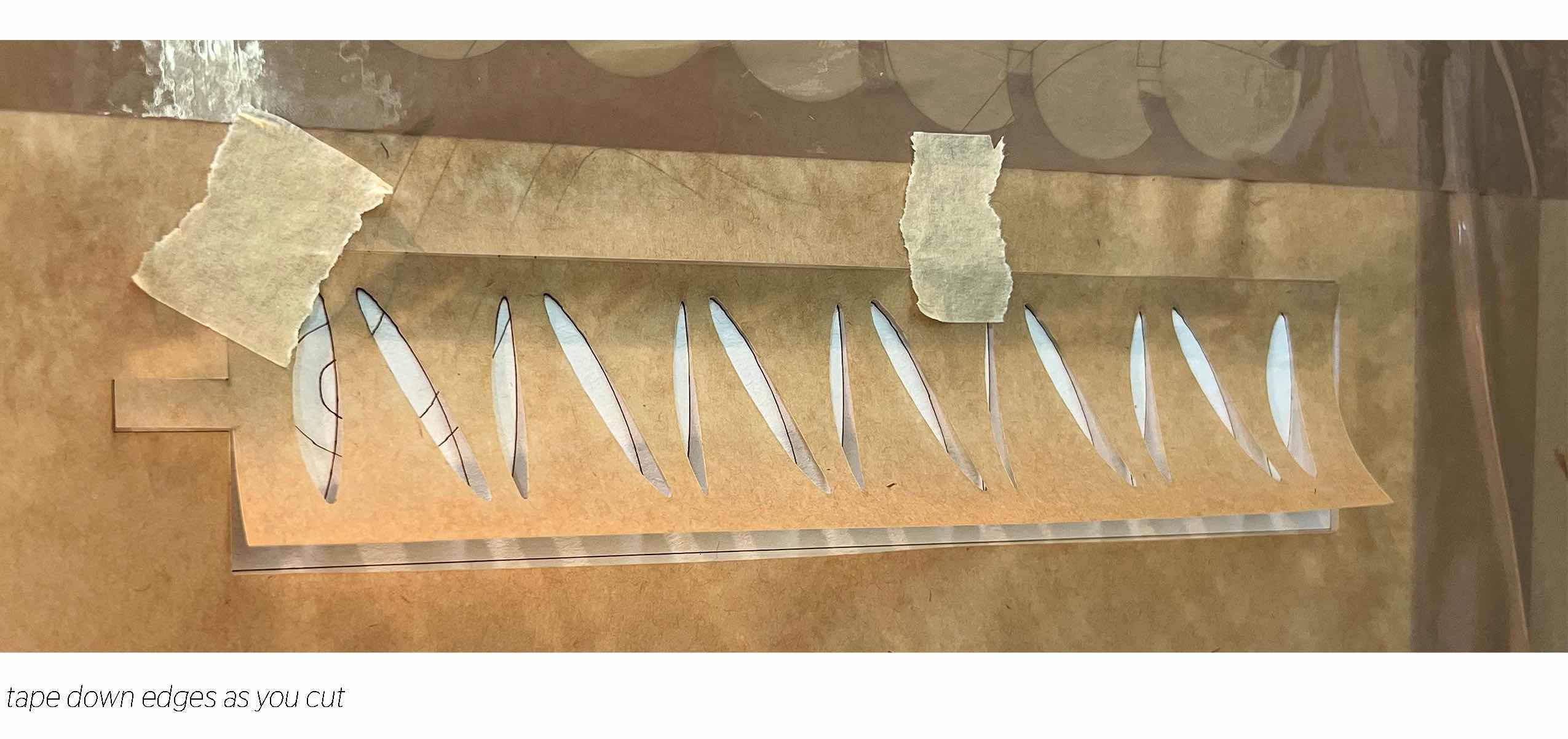
While cutting, continue to pause and tape down any paper pieces that may get in the way of the laser. Make sure to measure the diameter of the tube to make sure it can fit in the baking paper space
Step 3 - Heat Pressing Vinyl¶
Make sure you lay the vinyl with the plastic coating facing outwards and the plain side facing in towards the baking paper. You will remove the plastic coating once it is sealed. Use a heat press or an iron to join the vinyl pieces together, careful not to hold them in heat for too long because they can burn.
 The baking paper prevents the vinyl from sealing in places and creates the cavities for air to inflate.
The baking paper prevents the vinyl from sealing in places and creates the cavities for air to inflate.
 I tested the samples by adding a tube in the hole and blowing with my mouth or with a syringe.
I tested the samples by adding a tube in the hole and blowing with my mouth or with a syringe.
Results¶
Left: first sample
Right: second sample

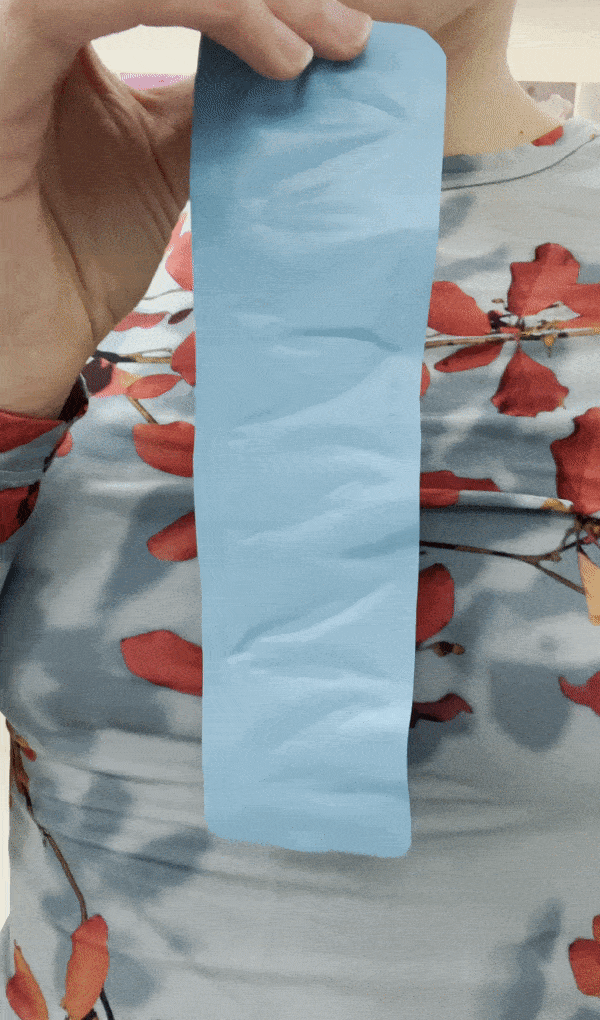
For the 3rd sample I added paper petal shapes on the side.


Fabrication files¶
-
File: Lungs laser cut file ↩
-
File: Twists laser cut file ↩